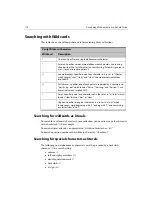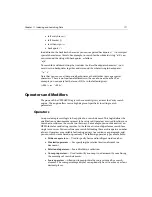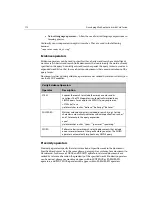
184
Developing Web Applications with ColdFusion
Understanding the Web Application Framework
A ColdFusion application is a collection of application pages that work together.
Applications can be as simple as a guest book or as sophisticated as a full Internet
commerce system with catalog pages, shopping carts, and reporting. You can combine
individual applications to create advanced Web systems.
You create a special template, named
Application.cfm
, which you place in the root
directory of the application. All the other templates in the application are stored in
directories below the application’s root directory.
The ColdFusion Web Application Framework is based on four basic components:
•
Application-level settings and functions
•
Client state management
•
Custom error handling
•
Web server security integration
With these components, you can easily combine your ColdFusion application pages
into sophisticated Web applications.
Application-level settings and functions in Application.cfm
ColdFusion offers application-level features that help you control settings, variables,
and features available across the entire application. Once you have defined an
application, you can use the application-level features in addition to all of the other
features in ColdFusion.
Client state management
Because the Web is a stateless system, each connection a browser makes to a Web
server is unique in the eyes of the Web server. However, within an application it is
important to be able to keep track of users as they move through the pages within the
application. This is the definition of client state management.
An application maintains client state by seamlessly tracking variables for a browser as
the user moves from page to page within the application. This can be used in place of
other methods for tracking client state such as using URL parameters, hidden form
fields, and HTTP cookies.
ColdFusion creates a client record for each browser that requests an application page
in an application in which client state management is enabled. The client record is
identified by a unique token that is stored in an HTTP cookie in the user’s browser.
The application can then define variables within the client record. These client
variables are accessible as parameters in every application page that the client
requests within the scope of the application.
Summary of Contents for COLDFUSION 4.5-DEVELOPING WEB
Page 1: ...Allaire Corporation Developing Web Applications with ColdFusion ColdFusion 4 5...
Page 14: ...xiv Developing Web Applications with ColdFusion...
Page 26: ...xxvi Developing Web Applications with ColdFusion...
Page 34: ...8 Developing Web Applications with ColdFusion...
Page 70: ...44 Developing Web Applications with ColdFusion...
Page 84: ...58 Developing Web Applications with ColdFusion...
Page 114: ...88 Developing Web Applications with ColdFusion...
Page 148: ...122 Developing Web Applications with ColdFusion...
Page 174: ...148 Developing Web Applications with ColdFusion...
Page 208: ...182 Developing Web Applications with ColdFusion...
Page 244: ...218 Developing Web Applications with ColdFusion...
Page 274: ...248 Developing Web Applications with ColdFusion...
Page 288: ...262 Developing Web Applications with ColdFusion...
Page 300: ...274 Developing Web Applications with ColdFusion...
Page 350: ...324 Developing Web Applications with ColdFusion...
Page 362: ...336 Developing Web Applications with ColdFusion...






























